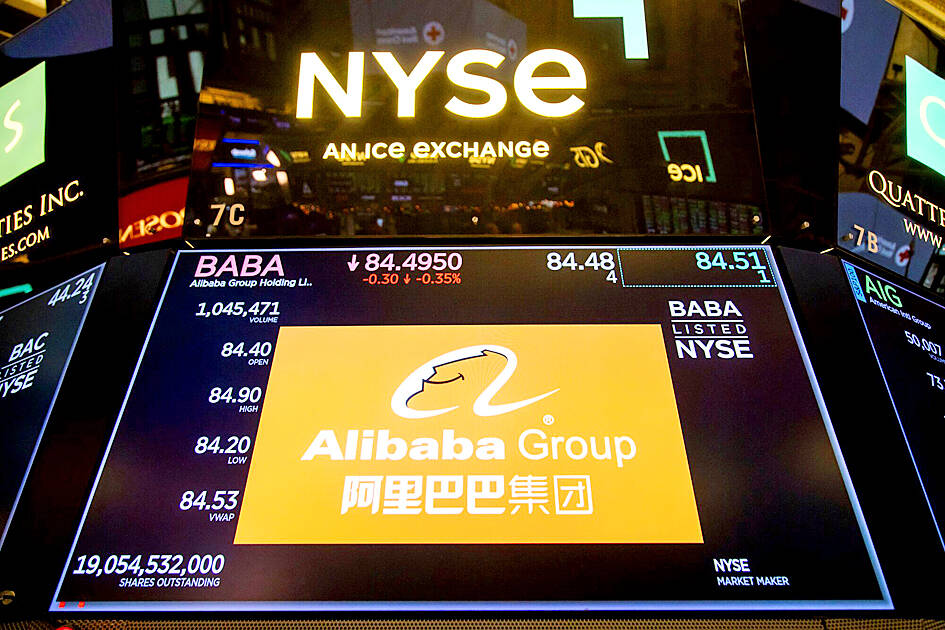Chinese technology company Alibaba Group Holding Ltd (阿里巴巴) yesterday released a new version of its Qwen 2.5 artificial intelligence (AI) model that it said surpassed the highly acclaimed DeepSeek-V3.
The unusual timing of the Qwen 2.5-Max’s release, on the first day of the Lunar New Year when most Chinese people are off work and with their families, points to the pressure Chinese AI start-up DeepSeek’s (深度求索) meteoric rise in the past three weeks has placed on not just overseas rivals, but also its domestic competition.
“Qwen 2.5-Max outperforms ... almost across the board GPT-4o, DeepSeek-V3 and Llama-3.1-405B,” Alibaba’s cloud unit said in an announcement posted on its official WeChat account, referring to OpenAI and Meta Platforms Inc’s most advanced open-source AI models.

Photo: Bloomberg
The Jan. 10 release of DeepSeek’s AI assistant, powered by the DeepSeek-V3 model, as well as the Jan. 20 release of its R1 model, has shocked Silicon Valley and caused tech shares to plunge, with the Chinese start-up’s purportedly low development and usage costs prompting investors to question huge spending plans by leading AI firms in the US.
However, DeepSeek’s success has also led to a scramble among its domestic competitors to upgrade their own AI models.
Two days after the release of DeepSeek-R1, TikTok owner ByteDance Ltd (字節跳動) released an update to its flagship AI model, which it said outperformed Microsoft Corp-backed OpenAI’s o1 in AIME, a benchmark test that measures how well AI models understand and respond to complex instructions.
This echoed DeepSeek’s claim that its R1 model rivaled OpenAI’s o1 on several performance benchmarks.
The predecessor of DeepSeek’s V3 model, DeepSeek-V2, triggered an AI model price war in China after it was released in May last year.
The fact that DeepSeek-V2 was open-source and unprecedentedly cheap, only 1 yuan (US$0.14) per 1 million tokens — or units of data processed by the AI model — led to Alibaba’s cloud unit announcing price cuts of up to 97 percent on a range of models.
Other Chinese tech companies followed suit, including Baidu Inc (百度), which released China’s first equivalent to ChatGPT in March 2023, and the country’s most valuable Internet company, Tencent Holdings Ltd (騰訊).
Liang Wenfeng (梁文鋒), DeepSeek’s enigmatic founder, said in a rare interview with Chinese media outlet Waves in July last year that the start-up “did not care” about price wars and that achieving AGI (artificial general intelligence) was its main goal.
OpenAI defines AGI as autonomous systems that surpass humans in most economically valuable tasks.
Liang said he believed China’s largest tech companies might not be well suited to the future of the AI industry, contrasting their high costs and top-down structures with DeepSeek’s lean operation and loose management style.
“Large foundational models require continued innovation, tech giants’ capabilities have their limits,” he said.

Taiwan Semiconductor Manufacturing Co (TSMC, 台積電) last week recorded an increase in the number of shareholders to the highest in almost eight months, despite its share price falling 3.38 percent from the previous week, Taiwan Stock Exchange data released on Saturday showed. As of Friday, TSMC had 1.88 million shareholders, the most since the week of April 25 and an increase of 31,870 from the previous week, the data showed. The number of shareholders jumped despite a drop of NT$50 (US$1.59), or 3.38 percent, in TSMC’s share price from a week earlier to NT$1,430, as investors took profits from their earlier gains

In a high-security Shenzhen laboratory, Chinese scientists have built what Washington has spent years trying to prevent: a prototype of a machine capable of producing the cutting-edge semiconductor chips that power artificial intelligence (AI), smartphones and weapons central to Western military dominance, Reuters has learned. Completed early this year and undergoing testing, the prototype fills nearly an entire factory floor. It was built by a team of former engineers from Dutch semiconductor giant ASML who reverse-engineered the company’s extreme ultraviolet lithography (EUV) machines, according to two people with knowledge of the project. EUV machines sit at the heart of a technological Cold

TAIWAN VALUE CHAIN: Foxtron is to fully own Luxgen following the transaction and it plans to launch a new electric model, the Foxtron Bria, in Taiwan next year Yulon Motor Co (裕隆汽車) yesterday said that its board of directors approved the disposal of its electric vehicle (EV) unit, Luxgen Motor Co (納智捷汽車), to Foxtron Vehicle Technologies Co (鴻華先進) for NT$787.6 million (US$24.98 million). Foxtron, a half-half joint venture between Yulon affiliate Hua-Chuang Automobile Information Technical Center Co (華創車電) and Hon Hai Precision Industry Co (鴻海精密), expects to wrap up the deal in the first quarter of next year. Foxtron would fully own Luxgen following the transaction, including five car distributing companies, outlets and all employees. The deal is subject to the approval of the Fair Trade Commission, Foxtron said. “Foxtron will be

INFLATION CONSIDERATION: The BOJ governor said that it would ‘keep making appropriate decisions’ and would adjust depending on the economy and prices The Bank of Japan (BOJ) yesterday raised its benchmark interest rate to the highest in 30 years and said more increases are in the pipeline if conditions allow, in a sign of growing conviction that it can attain the stable inflation target it has pursued for more than a decade. Bank of Japan Governor Kazuo Ueda’s policy board increased the rate by 0.2 percentage points to 0.75 percent, in a unanimous decision, the bank said in a statement. The central bank cited the rising likelihood of its economic outlook being realized. The rate change was expected by all 50 economists surveyed by Bloomberg. The